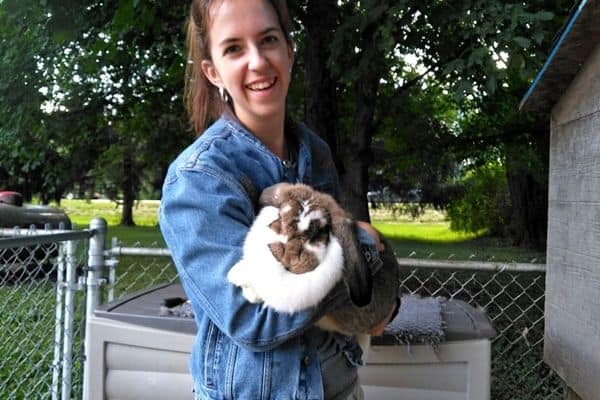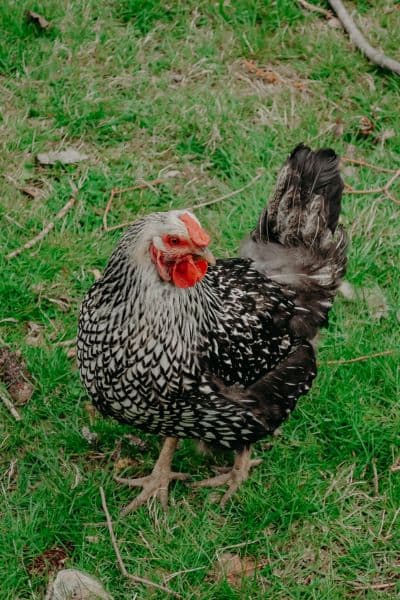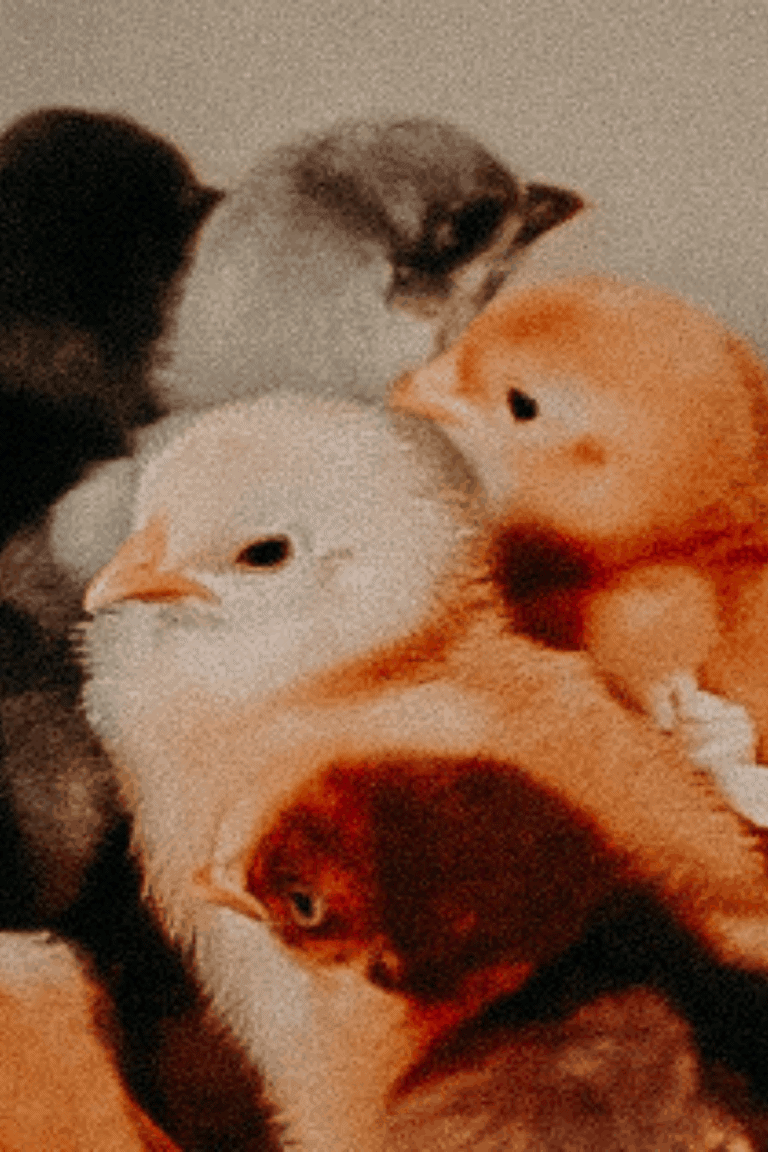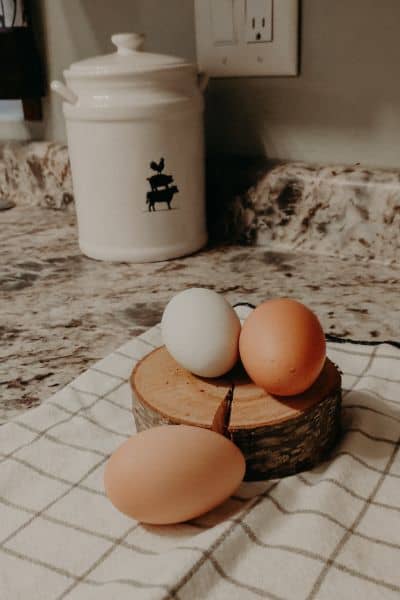7 Best Tips How To Start A Farm With Animals Advice You Can’t Afford To Miss
If you are wondering how to start a farm with animals you are in the right place.
I will share which animals will be the easiest to start with in a second. But there are some key things that you need to think about BEFORE I get into which farm animals are going to be the best ones to start with.
It can be tempting to what to buy all the animals for your backyard farm that pull on your heartstrings. But if you want to raise animals with intention and not have all of these animals literally eating all the extra cash in your wallet. You need to plan a few things out first.
#1 – Think About Your Goals
Think about the end goal that you want for your backyard farm.
- Do you want to only be selling livestock for income?
- Do you want to eventually sell other types of products like soaps and yarn?
- Do you want to have an online store where you sell those products?
- Or maybe you are only getting farm animals to give something for your family to do off the screens.
- Maybe you want to be known more for your friendly pet-type animals. I know of someone who has the goal of developing her milk cow herd to provide good milk cows for other homesteaders.
Or you want to raise only production animals where you are selling to them market.
The goal that you choose will also dictate the choices you make. Here is what I mean.
GOAL: To give your family something to do. ACTIONS: Very budget focused but the animals you buy can be a little bit heart-led.
GOAL: To make a side income for your family. ACTIONS: Very calculated, data-driven, practical choices and not heart-led.
Does that make sense?
#2 – Think About Your Lifestyle
Think about your current lifestyle. The way you live and your schedule.
Maybe you need to have something that is sustainable with a day job, raising kids, or homeschooling. Before you get started with anything think about the life you want to live now. And the life you want to live 5 to 10 years down the road.
If you don’t see things changing then getting dairy goats that require daily or twice daily milking is not going to be worth the stress when you are in a busy season of life.
Anytime we want to leave to go on vacation it’s a challenge to find someone to come and house-sit. Rabbits might seem easy but when you have a few thousand dollars in animals it’s a little nerve-racking to trust them to someone else who you are not sure we’ll recognize when something goes wrong.
And chickens, well some people are afraid of them and they are pretty messy. So it can be hard to find people who are willing.
(I was so happy when I finaly go t them to walk ahead of me and go to the bowls at feeding time instead o ftripping me up!😆😆Oh the little things.)

Plus, no one knows how to take care of your animals better than you. Can I get an amen from all the obsessive animal mommas!
So think about the type of life you want to live first before you start bringing on all types of animals. It’s going to be even more difficult if you have something like a dairy animal that needs to be milked or having someone take care of an animal that might be a little messy for some people.
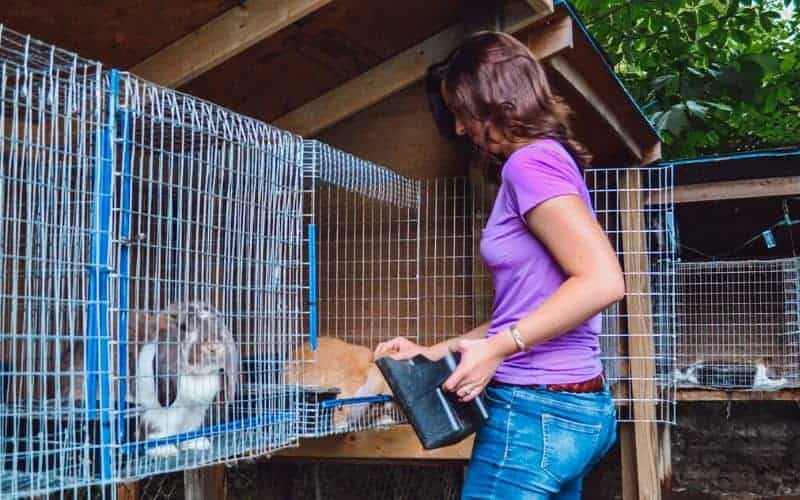
#3 – Put It To The Test
Before you buy any animals or supplies a want you to write all your ideas of farm animals you might want to raise on paper. We are going to put them to the test.
For these three categories below you are going to put a 1 if you know nothing or the cost is really high. So a bad score. And a 5 if you know pretty much all there is to know or the start-up cost is low. So a good score. Make sense?
#4 – Start-up Costs
Consider your start-up cost go through and write down everything you will need to raise the animal you want to raise.
And don’t just think about day-to-day living in caring for the animal. Think about breeding and future babies on your hobby farm and what that is going to require. But also remember that ugly can do the job. It doesn’t have to be fancy.
Look For Supplies You Already Have
Look around at what you have now that could work. What kind of supplies do you already have on your farm?
Do you know someone you can borrow supplies from? We have lots of chick supplies and we let my inlaws borrow them if we aren’t using them at the time.
Make a list of all the supplies you have and get creative, can use a coffee can for a feed scoop. It might seem trivial but saving $6-$9 is money you can put towards something else.
Go through that list and compare it to your startup list of the animal you are thinking if starting with. See what you already have and what you have to buy.
Put a 1 if you have to buy everything. And a 5 if you have very little or nothing to buy.
#5 – Your Knowledge Base
Think about your knowledge base. What do you already know how to take care of? And what animals are you going to have to completely learn from scratch? If you’re going to have to take the time to learn about them it’s going to be a much slower startup. It might also come with a lot of issues because you don’t know what you don’t know. Problems will come from that.
Find people who you can email or DM on social and ask questions. Be considerate of their time and don’t expect answers in 24hrs but most people are raise an animal they love will be more than willing to share what they know.
Also, consider that some animals are harder to raise than others. Goats actually have a good amount of complications to them they seem pretty easy but when it comes to warming and breeding they can be a bit finicky. Rabbits also are not the easiest to breed and raise.
Now don’t let what I just said scare you. If there’s something you really enjoy or you think you would enjoy raising and you have a lot to learn then, by all means, learn it!
There is so much joy in learning something new but if you’re hoping to make progress and your hobby farm quickly then starting with something you don’t know anything about is going to be difficult. You might have a bit of a bumpy road ahead…
If you are a fighter and willing to start out with a little bit of a learning curve then go for it but if you’re the type to give up when things get tough then definitely start with something you know.
# 6 – What Do You Enjoy Most?
You don’t want to start work that you hate. So make sure you enjoy working with the species or breed you intend to start with.
This might be hard if you have never had a particular animal but if you have been around them its worth thinking about. If you are trying to figure out if you like something or not go to a fair that has those animals. (make sure to check the schedule before you go. Most fairs don’t have all animals stay the whole week.
#7 – Prioritize Your List
Make a list of the animals you want to start raising and put the ones that you want to start with at the top of the list. The animals that will need to wait at the bottom. This list is going to be your go-by.
When you’re tempted to buy any animal that is further down the list then it’s something you need to think about before jumping in. Look back at your farm goals and re-evaluate your motives. Do they still align with what you want? If the answer is yes then it a not right now.
Top Easy To Care For Animals To Start Raising On Your Farm
#1 Ducks
Ducks are one of THE FASTEST growing poultry there is. Peakin ducks especially.
Before I get you too excited I will say that ducks are mess makers and they poop every 7 seconds. Yep, not the cleanest birds out there. But they are very easy to get started with and their eggs are great for baking. They will make your cakes very moist.
Basic Care: They need a heat lamp for the first 4-5 weeks, and eat poultry crumbled feed. And keep water access to a minimum. They will play like crazy even in their water bowl So I have found that if you keep the water at beak height they can’t cause too big of a mess. You can also limit the amount of water and just water them multiple times a day. Otherwise, you will be changing the tub every few hours.
Cons: They poop a lot, and will find a way to play in any amount of water.
Pro tip: They get big fast. So I would not get ducklings until the outside temperatures are above 75 degrees. So when they get too big for plastic toast you can move them outside. There is nothing worse than having big birds stuck indoors.
Top Duck Breeds: For Best Laying Kaki Camble or Sweedish. For meat Peakin (duck is amazing I promice)
#2 Chickens For Eggs
Once you get chickens past the “chick” stage. They are very easy to keep. But this can take time. They will likely be inside for 8-12 weeks which can feel like an eternity. Besides needing to be fully feathered to go outside they need to be a bit bigger so they don’t get eaten or killed for one reason or another. This ebook will give you all you need to know about raising chickens.
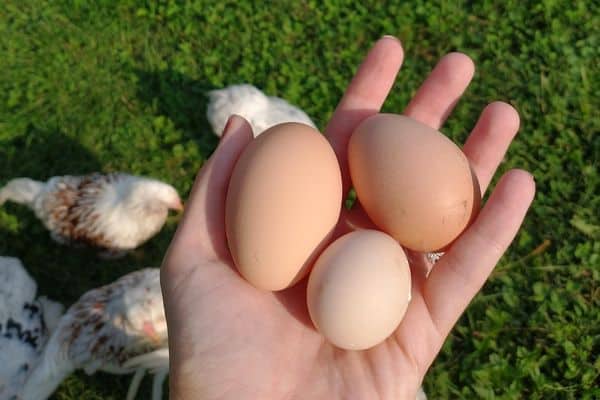
Basic Care: They just need food and water every day once they are fully grown.
Cons: They need to be protected from predators. They are #1 on the food list for things like raccoons, skunks, weasels, hawks, and coyotes. Read more about how to keep hawks away from your chickens here.
Best Breeds:
- Leghorns are going to be the best breed designed to put all their energy into laying. BUT if you live in a colder climate you will need to heat the coop to keep it warm enough so they don’t burn all their energy staying warm. That can get expensive.
- Australorps have proven great layers as another alternative.
- Cochin is my FAVORITE. They are a large breed that are chunky and very well feathered. They don’t mind the cold as much and as long as you give them the 14hrs of daylight they will do just fine.
Here is another good read to learn more about 10+ Small Chicken Breeds For Homesteaders With Small Pieces Of Land
If you are totally new to raising chickens and you want an easy-to-get-started guide that gives you all the details you need to know without the fluff. Check out this beginner’s guide to raising chickens. Its ONLY $9!!😲
#3 Meat Chickens – Cornish Rock Cross
Meat chickens do take some skill but they grow FAST. So if you learn the care well you will be able to harvest them before the summer is even up. I have a full care guide here.
Basic Care: Feed them on HIGH protein, free feed, and keep them warm. You can get them to butcher weight by 9 weeks or less if you do it right.
Cons: They are the pig of poultry. Total mess makers and smelly. You will be changing tubs and pens often so think disposable.
Pro Tip: Don’t get them until it is at least 75 degrees outside. Because you want to keep them warm (but not too hot) or they will put all their energy into keeping warm and not turning that food into meat. Think of it as they have a singular focused metabolism. They can’t do too much at once.
Get all my tips and tricks for raising meat chickens here.
#4 Turkeys – Broad Breasted
Turkeys are AWESOME and about the same as meat chickens. They just take a bit longer. Otherwise, they are a close tie.

A meat (Broad Breasted Bronze or White) turkey takes about 14-18 weeks to get to butcher’s weight. The heritage turkeys are another story. You can read about bourbon reds here.
Basic Care: Again HIGH protein and free feed them. The faster they grow the sooner you can harvest. And the longer you wait the less they will convert to feed to meat.
Cons: You need about 3 square feet per bird. They also need to be contained. They don’t “fly” per say but they will jump a good ways and it is their natural instinct to roost in trees or high up to stay away from predators.
Best Breeds: Broad Breasted White for meat. But if you want them to reproduce then a heritage breed is your next choice. The broad breasted can’t/don’t do well with breeding on their own.
#5 Rabbits
Adult rabbits are easy to care for. It’s the raising litter that is HARD.
Basic Care: They need feed and water every day. Basic nail trimming every 8 weeks.
Cons: Litters can die easily and when the adult rabbits get sick they often go down quickly and with no time to save them.
Best Breeds: Newzeland or Californians are the most popular and mature quicker for meat but a pretty small. You will only get a 3-pound animal if you harvest them around the typical 12-week point.
Here is my best guide on raising meat rabbits.
Start With One Or Two Animals
Like I said even if you know a little bit about one of the animals you’re going to start with you might have a few hiccups down the road. If you are trying to learn and take care of five new species at once you’re going to find it’s a struggle and you might be in over your head and burn out.
But if take the time to learn one animal at a time well, it becomes second nature to you then you won’t have as hard of time starting your hobby farm. This is a great easy-to-read ebook about raising and keeping chickens.
Start with no more than two animal types in one year. Don’t at more until you are comfortable with the ones you have.
Read this post If you want a few tips for selling livestock for profit.

A hobby farm can be a great joy. But if you start too quickly and get in over your head raising all the animals that perk your interest at once you’re going to be in too deep.
It should be something you love and be an addition to your life not take over it. Start small and grow from there. If you’re willing to take it slow and learn hard you will see a successful hobby farm.
